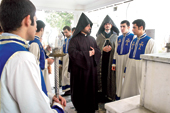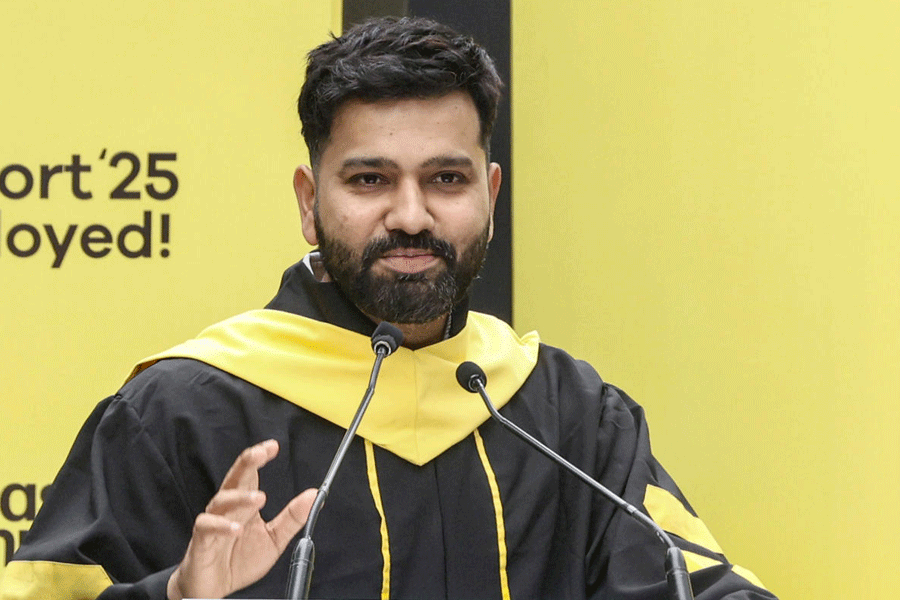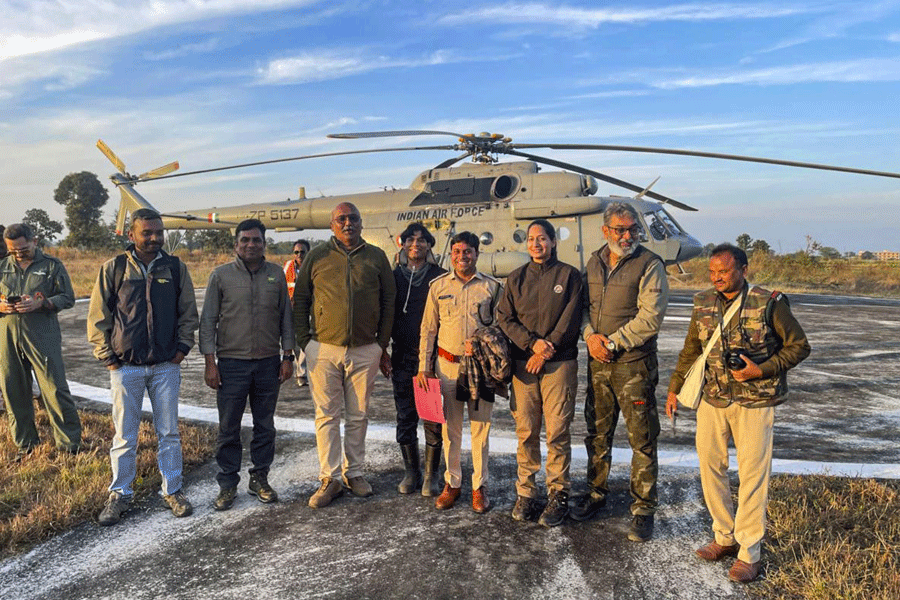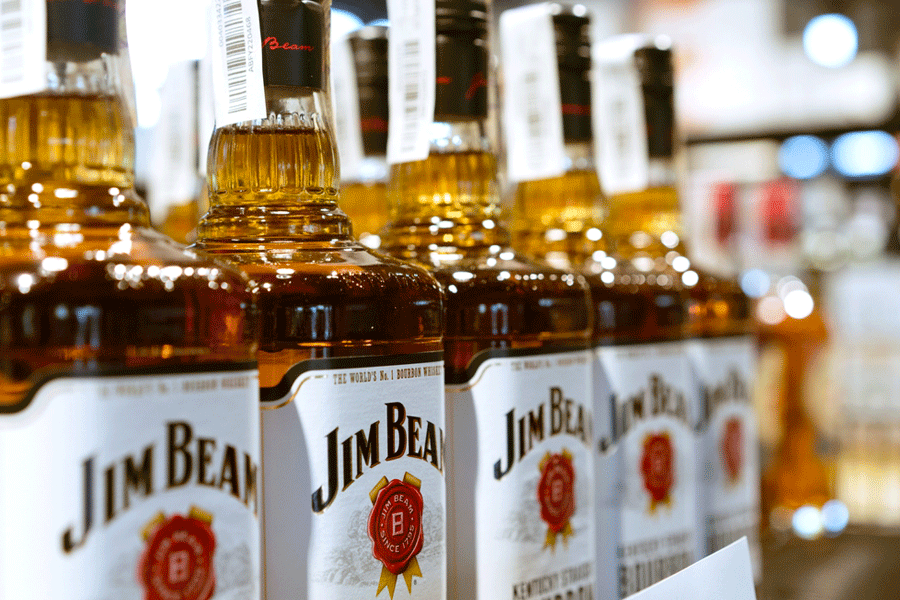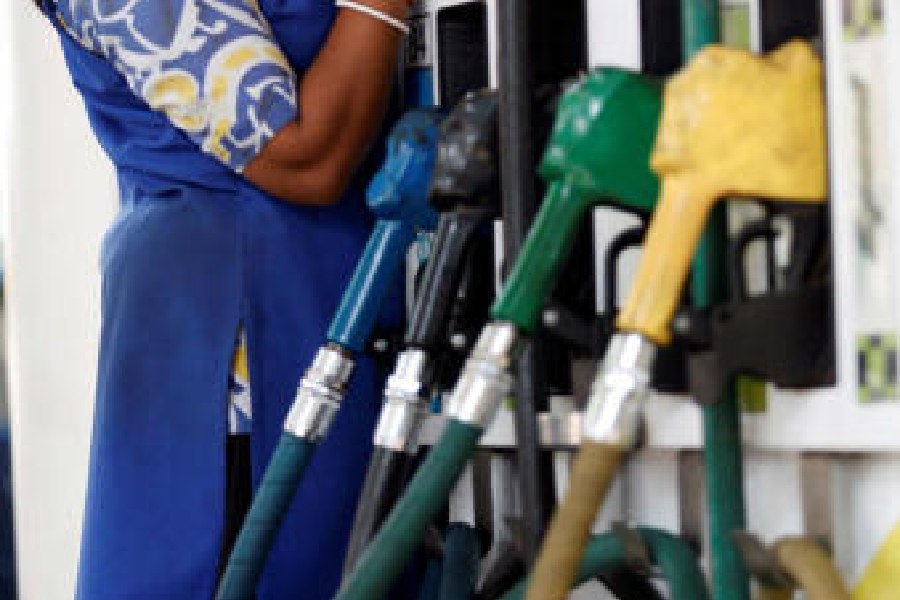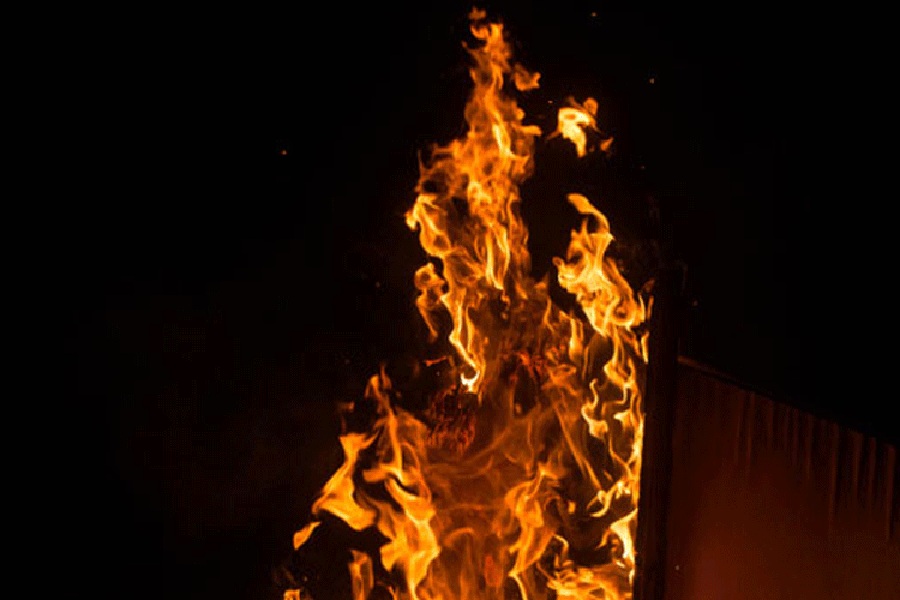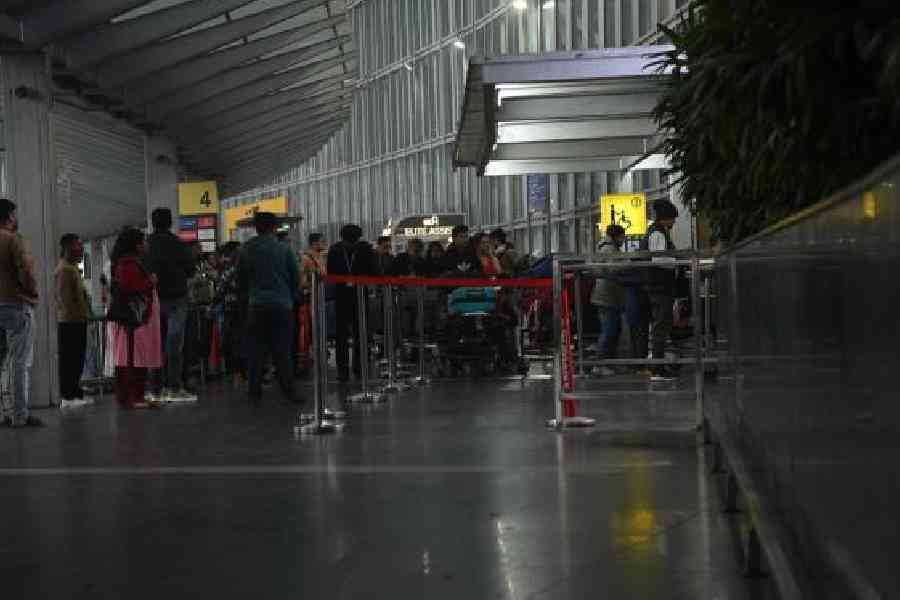 |
| Remembering the Armenian genocide. Pictures by Bishwarup DuttaThe Holy Church of Nazareth off Brabourne Road (top) and an Armenian wedding ceremony in the city |
A black coffin box is brought in. Flowers are laid over it and prayers said. Then the altar-boy carries out the coffin and makes three rounds of the church with it. They rest the box in front of the altar and you come and make a cross in front of it and take one flower from the coffin. It is said to be lucky to keep the flower with you.
The Good Friday service is in progress at St Gregory’s Chapel near Park Circus. It is beautiful, sombre and dignified, an anomaly compared with the chaos outside.
The Holy Church of Nazareth, located off Brabourne Road, at the north-west corner of Burrabazar near Howrah bridge, is beautiful too. Built in 1724, it is said to be the oldest church in Calcutta. The interiors are done up in marble, and the overhead gallery in mural tablets. The church is built over an old Armenian cemetery.
The city has been home to the Armenian community since the 17th century. The Armenians came here before the British did and settled down, as they did in other parts of India, such as Kerala and Surat. Many of the first Armenians to come to the city were businessmen. In the years that followed, Armenians contributed much to the built heritage of the city.
All that remains of this past in Calcutta are the churches, the Armenian College on Free School Street (the building where British author William Makepeace Thackeray was born; the building was acquired by the community later), the quaint surnames, such as Hyrapiet, Hovhannisyan or Arathoon, and the feeling that Armenians still hang out somewhere there when Stephen Court burns down and Irene Harris, the granddaughter of Arathoon Stephen — the business tycoon who built the mansion — is found sitting forlorn outside the building on Park Street on a desolate morning.
 |
| The Holy Church of Nazareth off Brabourne Road. Picture by Bishwarup Dutta |
The Armenian community in Calcutta has only about 40 families left. The community has married into other communities. Many do not speak Armenian now. It would be ridiculous for most from the community to greet another with a Bharave zeez (good morning) or sign off with a Bari esheir (good night), words that are difficult to write in the Roman script because of its difference from the Armenian one.
And whatever is Armenian food?
So when 30-year-old Shayne Hyrapiet, the singer well-known in the party circles in the city, married his Punjabi girlfriend Nidhi Bakshi in December 2009, it was just another church wedding, except that the bride and groom not only exchanged rings, but they were “crowned” and the wedding ring was placed on the right hand — an Armenian custom.
Shayne is Armenian on his father’s side and the wedding took place at the Holy Church of Nazareth. “The wedding was very beautiful. There were a lot of Armenian songs and the service was very pretty,” says Shayne, who also had a Punjabi wedding. But Shayne didn’t understand the songs. “I don’t know Armenian at all,” he declares. Nor was the wedding feast Armenian. “We had Indian, Italian, Continental and Mughlai dishes, but no Armenian food as no caterer in the city makes that cuisine,” he says.
He is not even sure what Armenian food is. If Shayne’s father is Armenian, his mother and paternal grandmother are of Anglo-Indian origin. “Frankly speaking, I am Armenian just by birth and baptism. I celebrate Id, Dussehra and Diwali as also Christmas and Easter. I play Holi,” says Shayne.
His father, Peter Hyrapiet, is the president of the Armenian Club in Calcutta and also a member of the church committee.
 |
| An Armenian wedding ceremony in the city.Picture by Bishwarup Dutta |
At home, says Peter, the food was always rice and curry and vindaloo, which makes it rather Anglo-Indian. The communities share more than a taste in food. Like Anglo-Indians, most Armenians left the city and the country. “Many went away to Australia and the UK. I too sent my son and daughter to Australia to look for better prospects,” says 89-year-old Charles Sarkies, fondly known as Chacha, the oldest Armenian in the city.
Sarkies, an Iranian Armenian, moved to India in 1934 as a 13-year-old and joined the Armenian school. “Armenians started mining in Calcutta, but before I retired I was the only Armenian left in the profession,” he says.
But there is a strange, live connection with current Armenia.
The Armenian College formally called Armenian College and Philanthropic Academy, which was established in 1821, is a bit of a surprise. Of the 80-odd students, only three are Indian Armenians. The rest are from Armenia, Iran and other places in the world where the Armenians are settled.
Armenia, with its troubled past of centuries, and especially after the Armenian genocide of 1915 carried out by the Ottoman Turks who killed, according to historian Arnold Toynbee, 6,00,000 people, had its people spreading out to several parts of the world.
Armenia, after Turkish rule, became part of the Soviet bloc.
The faculty at the school is a mix of Indian and Armenian. The school follows the ICSE system. The first language is English; Armenian is the second. Armenian history is also taught.
“We had the facility, but not enough students. So we decided to get students from elsewhere,” says Fr Khoren Hovhannisyan, the manager of the school and pastor of the Armenians in India.
But why would Armenians send their children to be educated in distant, obscure Calcutta? “Because of the wars and their effect, some parents who get the opportunity, send their children to the Armenian College in Calcutta. It is free and the children are taken care of well,” says Vachagan Tadevosyan, an Armenian musician who came to teach at the school in 1999. He now teaches music at La Martiniere for Boys and trains the choir at the Armenian College.
That the school is governed by the church is an additional attraction; the church enjoys a special place with Armenians. The country was the first to declare itself a Christian nation in ancient times. Besides, the school takes care of all the expenses of the students, including their trips back home.
Fr Ignatios joined Armenian College and the parish in Calcutta in December 2009. “Work is interesting. But there is a lot of noise around here,” says the 33-year-old priest apologetically.
Two young, pleasant-looking Armenian teachers nod and smile. They cannot speak English. The students are shy. Many have gone back to their countries for summer vacation, one is told.
But the boys from Armenia bring the community closer to the roots. At programmes at the club, the boys from the school perform Armenian folk songs and dance, says Peter Hyrapiet. He has put up the Armenian alphabet on the club walls.
Once a year the community travels together to Chinsurah where they have the old St John’s Church. Once a year, they commemorate the day of the “Great Crime”, the day of the massacre of the Armenians by the Ottoman state.
Christmas is observed on January 6, not December 25.
As for the rest of the days, there’s no escaping the overwhelming nature of everyday Calcutta life.
Irene Harris did not study at Armenian College. “I don’t speak Armenian. I speak English and Hindoostani. I feel a little bad now that I don’t know my language, but then, my parents never spoke Armenian to me at home,” she says, in a pair of shorts and a shirt.
Asked about which identity is strongest in her, she promptly says: “Oh, I am a Calcuttawallah.” Twenty-four-year-old Donna Sidhu calls herself “first an Indian”. But she is proud of her Armenian roots, she says.
Donna has studied at the Armenian College. She has been part of the church choir and sung Armenian songs, but listens to anything and everything.
Thankfully, Armenian cuisine is not all lost in Calcutta. Peter Hyrapiet speaks of bland curries and kebabs and salted white Armenian cheese. “The lavash is an important part of Armenian food. It is like a naan, but oblong in shape,” he says.
Susan Reuben, the warden of the Armenian church, speaks Armenian (though her children can’t) and can make a few Armenian dishes, “thanks to my mother”. One of which is dolma — a stuffed delicacy. “Armenian cuisine uses very little spices,” she says.
She wears a salwar kameez because “it is comfortable” and her beautiful eyes are kohl-lined. The caller tune on her mobile is: Oh boy you are mine…, a song from the Akshay Kumar-starrer Housefull.
Hall of Fame
Dr Stepen Owen Moses:
Initiated the St John’s Ambulance Courses in Calcutta and also put into service the first Red Cross ambulance in the city during the first world war.
Dr Marie Catchatoor:
Was the first woman to be appointed Presidency Surgeon by the government of West Bengal. After an illustrious career, she retired as the superintendent of Lady Dufferin Hospital.
Sir Gregory Charles Paul:
Born in Calcutta, Sir Gregory studied at Cambridge University before being appointed the advocate-general of Bengal during British rule. He was later knighted.
Arathoon Stephen:
The man who built Stephen Court and gave it his name. He also built the Grand Hotel.
Sir Catchick Paul Chater: Born in Calcutta and educated in La Martiniere for Boys here, he later became a successful businessman in Hong Kong and was knighted by the British. His benevolence helped build the Armenian Home in the city, called Sir Catchick Paul Chater Home.
Gauhar Jaan:
Few know that the courtesan who entertained royalty, was known both for her beauty and flamboyant lifestyle and was the first Indian to have her voice recorded was born Angelina Yeoward in an Armenian family.

